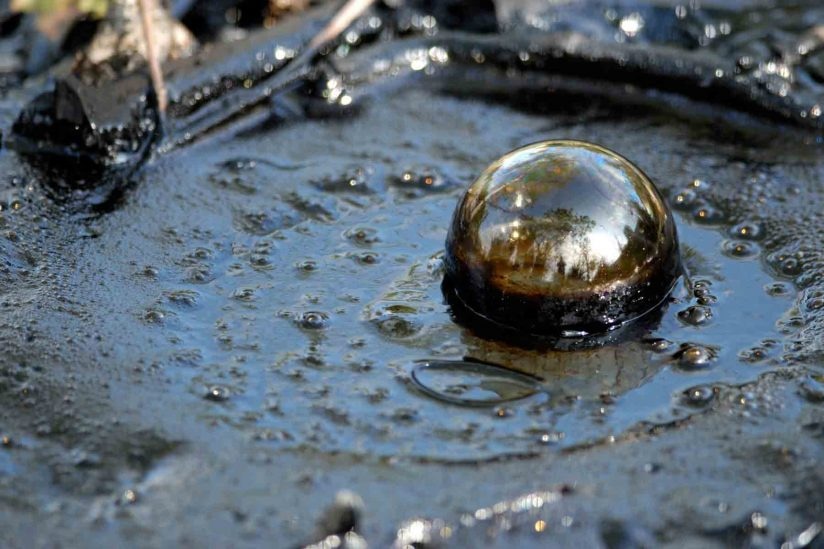Feb 6 2018
Scientists at Southern California have revealed a new, more efficient pathway for converting methane — a potent gas adding to climate change — directly into basic chemicals for making agrochemicals, plastics, and pharmaceuticals.
 The greenhouse gas methane — here bubbling in a tar pit — is found on the ground and in the air, with the presence of the latter significantly escalating over the last 10 years. (Photo/Martin Shields)
The greenhouse gas methane — here bubbling in a tar pit — is found on the ground and in the air, with the presence of the latter significantly escalating over the last 10 years. (Photo/Martin Shields)
In research published in the Journal of the American Chemical Society, chemists at the USC Loker Hydrocarbon Research Institute say they have found a way to help to use this plentiful and potent greenhouse gas, which is usually burnt or flared to create energy.
Among popular greenhouse gases, carbon dioxide is frequently cited as the largest culprit for trapping heat on Earth, which adds to climate change. But, it is not the most potent.
That distinction belongs to methane. According to the Intergovernmental Panel on Climate Change, methane traps heat and warms the planet 86 times more than carbon dioxide spanning a 20 year horizon.
More fuel, fewer emissions, reduced energy use
Lead author Patrice T. D. Batamack, senior author G. K. Surya Prakash and Thomas Mathew of the USC institute used a catalyst called H-SAPO-34, which was derived from a group of nanoporous crystals known as zeolites.
This simple technique of converting methane directly to propylene and ethylene, or olefin, would replace what are traditionally hard, costly and inefficient processes that introduce greenhouse gases to the atmosphere. The bulk of propylene and ethylene is created from petroleum oil and shale liquid cracking, which consumes massive quantities of energy.
When USC’s first Nobel Prize winner, George Olah, converted methane to olefin in 1985, the process needed three steps. Since then, researchers have decreased it to two steps, but the Loker team is the first to realize the conversion with a single catalyst based on zeolites.
Contact time is the key for this effective and simple catalyst to produce usable fuel from methane. In real estate, they say, location, location, location. In chemistry, it is all about condition, condition, condition.
G. K. Surya Prakash, Senior Author
Global methane emissions have surged since 2007, and output is mostly bad in the United States. According to a new study by Harvard University, the United States could be mainly responsible for nearly 60% of the worldwide growth in human-caused atmospheric methane emissions during this century.
Contributing to the worldwide surge is the increased supply of rice fields and livestock in countries like China and India, the two leaders in total methane output, according to the World Bank.
‘If carbon is the problem, carbon has to be the solution’
While being the most potent of the prevalent greenhouse gases, and even after the largest methane leak in U.S. history at the Aliso Canyon natural gas storage facility a few years ago, there are no signs that methane’s copious production will slow down anytime in the near future.
Shale fracking and other resource extraction methods are boosting natural gas reserves, and the Loker researchers believe methane may soon become the most popular of all raw materials for manufacturing petrochemical products.
About three decades ago, Prakash and his late mentor Olah first started refining the concept of “The Methanol Economy,” a horde of methanol-based solutions mitigating the production cycle of the greenhouse gases that are hastening climate change.
While similar in name and structure, methane is not directly interchangeable with methanol, though most methanol is synthetically created from methane. Methane is a naturally occurring gas and the simplest one-carbon compound comprising hydrocarbon.
By further minimizing the steps needed to capably convert methane to olefins, the researchers at the Loker institute are much closer to attaining one of the original steps proposed in “The Methanol Economy.”
If carbon is the problem, carbon has to be the solution. There is plenty of methane to go around in the world, and it has become easier and safer to turn it into products that we can actually use.
G. K. Surya Prakash, Senior Author
The study received support from the USC Loker Hydrocarbon Research Institute and the U.S. Department of Energy.